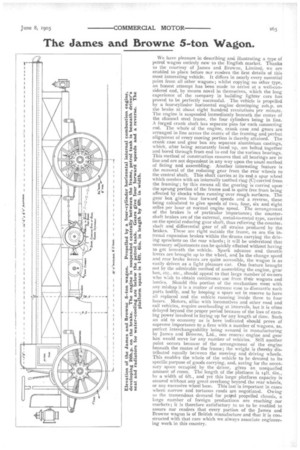The James and Browne 5-ton Wagon.
Page 21

If you've noticed an error in this article please click here to report it so we can fix it.
We have pleasure in describing and illustrating a type of petrol wagon entirely new to the English market. Thanks to the courtesy of James and Browne, Limited, we are enabled to place before our readers the first details of this most interesting vehicle. It differs in nearly every essential point from all other wagons; whilst copying no other type, an honest attempt has been made to arrive at a well-considered end, by means novel in themselves, which the long experience of the company in building lighter cars has proved to be perfectly successful. The vehicle is propelled by a four-cylinder horizontal engine developing zoh.p, on the brake at about eight hundred revolutions per minute. The engine is suspended immediately beneath the centre of the channel steel frame, the four cylinders being in line. A forged crank shaft has separate pins for each connecting rod. The whole of the engine, crank case and gears are arranged in line across the centre of the framing and perfect alignment of every moving portion is thereby attained. The crank case and gear box are separate aluminium castings, which, after being accurately faced up, are bolted together and bored through from end to end for the various bearings. This method of construction ensures that all bearings are in line and are not dependent in any way upon the usual method of fitting and assembling. Another interesting feature is the removal of the reducing gear from the rear wheels to the central shaft. This shaft carries at its end a spur wheel which meshes with an internally toothed ring (C) carried from the framing; by this means all the gearing is carried upon the sprung portion of the frame and is quite free from being affected by shocks when running over rough surfaces. The gear box gives four forward speeds and a reverse, these being calculated to give speeds of two, four, six and eight miles per hour at normal engine speed. The arrangement of the brakes is of particular importance; the countershaft brakes are of the external, metal-to-metal type, carried on the special reducing gear shaft, thus relieving the countershaft and differential gear of all strains produced by the brakes. These are right outside the frame, as are the internal expansion brakes within the drums carrying the driving sprockets on the rear wheels; it will be understood that necessary adjustments can be quickly effected without having to get beneath the vehicle. Spark advance and throttle levers are brought up to the wheel, and as the change speed and rear brake levers are quite accessible, the wagon is as easily driven as a light pleasure car. One feature brought out by the admirable method of assembling the engine, gear box, etc.; etc., should appeal to that large number of owners who wish to obtain continuous use from their wagons and lorries. Should this portion of the mechanism meet with any mishap it is a matter of extreme ease to dismantle such parts bodily, and by keeping a spare set in reserve to have all replaced and the vehicle running inside three to four hours. Motors, alike with locomotives and other road and rail vehicles, require overhauling at intervals, but it is often delayed beyond the proper period because of the loss of earning power involved in laying up for any length of time. Such an aid to economy as is here indicated should prove of supreme importance to a firm with a number of wagons, as perfect interchangeability being assured in manufacturing by James and Browne, Ltd., one reservc engine and gear box would serve for any number of vehicles. Still another point occurs because of the arrangement of the engine beneath the centre of the frame; the weight is thereby distributed equally between the steering and driving wheels. This enables the whole of the vehicle to be devoted to its specific purpose of goods carrying, and, saving for the necessary space occupied by the driver, gives an unequalled amount of room. The length of the platform is Wt. 61n., by a width of 6ft., and yet this large platform capacity is secured without any great overhang beyond the rear wheels, or any excessive wheel base. This last is important in cases where narrow and tortuous roads are negotiated. Owing ro the tremendous demand for petrol propelled chassis, a large number of foreign productions are reaching our markets; it is therefore satisfactory to us to be enabled to assure our readers that every portion of the James and Browne wagon is of British manufacture and that it is constructed with that care which we always associate engineering work in this country.


























